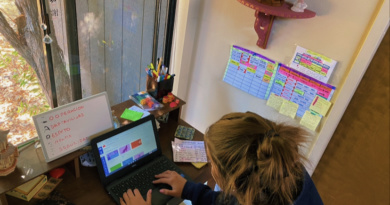Students dread CAASPP testing while school needs it
PHOTO: Saadya Mahmmood/HUB photo illusstration
By Juna Brothers
BlueDevilHUB.com Staff–
Every year it’s the same: as soon as the teacher mentions the acronym “CAASPP,” there is a cacophony of grumbles throughout the classroom.
The California Assessment of Student Performance and Progress, or CAASPP, is almost universally dreaded by juniors for its effect on their schedule and perceived uselessness. Although thought of as a nuisance, the tests serve many purposes.
Statewide assessments are required under federal and state law. The CAASPP, as it’s known today was introduced in 2014 with the purpose of assessing students’ performance in state standards in math, English language arts (ELA) and science, the core subjects that are required to be taught in California classrooms.
Vigdis Asmundson is the Education Research and Evaluation Administrator for the Science Office in the Assessment Development and Administration Division at the California Department of Education. This means that she manages all of California’s science assessments.
“Without data, it can be hard to identify what is working well and what isn’t working well. The CAASPP is a set of standardized tests, which means that the results are comparable statewide across all the students that take the test,” Asmundson said. Compared to the rest of the state, Davis High students score exceptionally well. Last year, an average of 31% of all California students met or exceeded math, ELA and science standards. For Davis High, the average was 64%.
Since school CAASPP data is available to California State University (CSU) schools, it can help admissions officers know that applicants are prepared for college.
Students have the option of sharing their own scores to CSUs as well, which AP Calculus teacher David Blackwell suspects is an overlooked bonus that CAASPP testing offers, especially since ACT and SAT scores are no longer considered in the admissions process.
“The better we do on these scores – if our school has a good reputation – the more that we’re apt to (have) more students get in (to CSUs) . . . While they’re not supposed to, it’s human nature to check rankings. And the only thing that’s standardized between all of us is the CAASPP scores,” Blackwell said.
If students are admitted to a CSU, their CAASPP scores are also used for course placement. Scoring higher allows students to start in more advanced classes. Additionally, CAASPP scores can be used to obtain a California State Seal of Biliteracy, something many DHS students are pursuing. Despite these benefits, a constant struggle at DHS is getting students to actually put an effort into the test.
“Some students will look at (the test) and go . . . ‘if it’s not counting (for) my grade, I’m not doing it’ . . . That (was) true 30 or 40 years ago, and it’s true now,” Blackwell said. Kristine Gladding, the DHS testing coordinator, agrees that convincing students to actually try their best on the CAASPP is the hardest part of organizing the whole testing process.
“It’s hard to get students (to) buy-in . . . we want everybody to feel like it’s important to take the CAASPP and to show up and do (their) best,” Gladding said.
CAASPP data is used at the district level to identify gaps in students’ knowledge and compare performance across different groups of students, examining results by race, gender, economic status and parent’s education levels, among other things.
These results can be incredibly valuable in adjusting curriculum to better meet student needs, but it’s important to keep in mind that these tests are only one metric of academic performance.
There will never be a perfect test. The California Department of Education is constantly looking for ways to improve statewide assessments, but any change requires a lot of time to develop.
“Each question on the (science) test goes through multiple rounds of development, beginning with identifying phenomena, writing questions, reviewing those questions with a panel of current science teachers, field testing the questions, and then analyzing the data from the field test,” Asmundson said.
Looking toward the future of CAASPP testing at DHS, only small adjustments are anticipated.
“I think … tightening down what we’re doing with technology would be something we would change to try to improve the system. But (for) the administration of the test, as long as it’s mandated by the state of California, we’ll keep doing it,” Gladding said.




